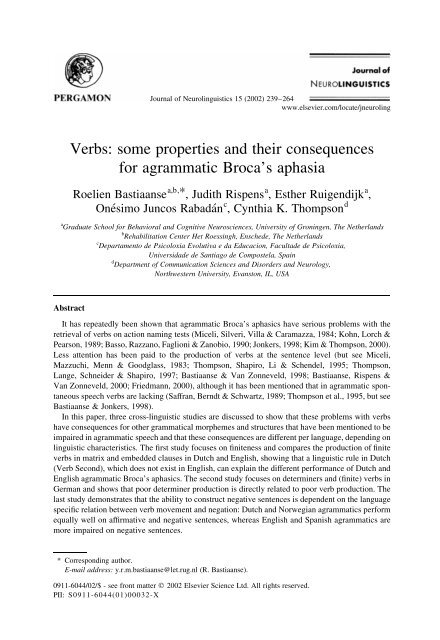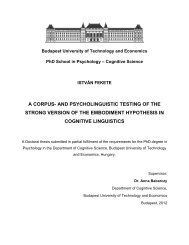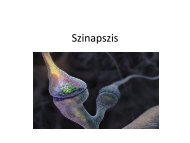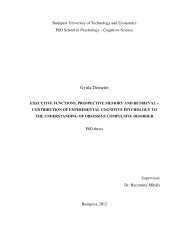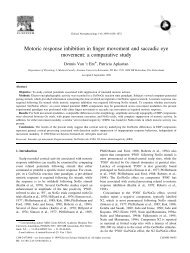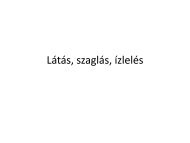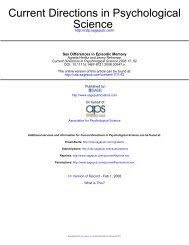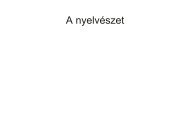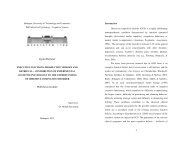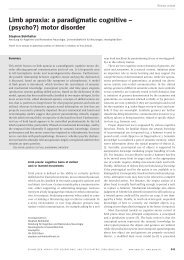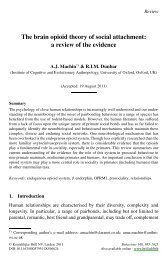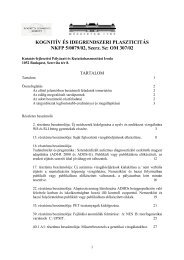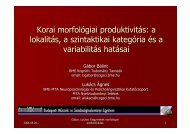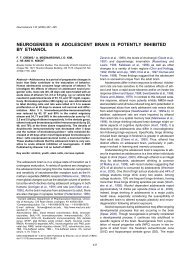Verbs: some properties and their consequences for agrammatic ...
Verbs: some properties and their consequences for agrammatic ...
Verbs: some properties and their consequences for agrammatic ...
You also want an ePaper? Increase the reach of your titles
YUMPU automatically turns print PDFs into web optimized ePapers that Google loves.
<strong>Verbs</strong>: <strong>some</strong> <strong>properties</strong> <strong>and</strong> <strong>their</strong> <strong>consequences</strong><br />
<strong>for</strong> <strong>agrammatic</strong> Broca's aphasia<br />
Roelien Bastiaanse a,b,*, Judith Rispens a , Esther Ruigendijk a ,<br />
OneÂsimo Juncos RabadaÂn c , Cynthia K. Thompson d<br />
a Graduate School <strong>for</strong> Behavioral <strong>and</strong> Cognitive Neurosciences, University of Groningen, The Netherl<strong>and</strong>s<br />
b Rehabilitation Center Het Roessingh, Enschede, The Netherl<strong>and</strong>s<br />
c Departamento de Psicoloxia Evolutiva e da Educacion, Facultade de Psicoloxia,<br />
Universidade de Santiago de Compostela, Spain<br />
d Department of Communication Sciences <strong>and</strong> Disorders <strong>and</strong> Neurology,<br />
Northwestern University, Evanston, IL, USA<br />
Abstract<br />
R. Bastiaanse et al. / Journal of Neurolinguistics 15 �2002) 239±264 239<br />
Journal of Neurolinguistics 15 �2002) 239±264<br />
www.elsevier.com/locate/jneuroling<br />
It has repeatedly been shown that <strong>agrammatic</strong> Broca's aphasics have serious problems with the<br />
retrieval of verbs on action naming tests �Miceli, Silveri, Villa & Caramazza, 1984; Kohn, Lorch &<br />
Pearson, 1989; Basso, Razzano, Faglioni & Zanobio, 1990; Jonkers, 1998; Kim & Thompson, 2000).<br />
Less attention has been paid to the production of verbs at the sentence level �but see Miceli,<br />
Mazzuchi, Menn & Goodglass, 1983; Thompson, Shapiro, Li & Schendel, 1995; Thompson,<br />
Lange, Schneider & Shapiro, 1997; Bastiaanse & Van Zonneveld, 1998; Bastiaanse, Rispens &<br />
Van Zonneveld, 2000; Friedmann, 2000), although it has been mentioned that in <strong>agrammatic</strong> spontaneous<br />
speech verbs are lacking �Saffran, Berndt & Schwartz, 1989; Thompson et al., 1995, but see<br />
Bastiaanse & Jonkers, 1998).<br />
In this paper, three cross-linguistic studies are discussed to show that these problems with verbs<br />
have <strong>consequences</strong> <strong>for</strong> other grammatical morphemes <strong>and</strong> structures that have been mentioned to be<br />
impaired in <strong>agrammatic</strong> speech <strong>and</strong> that these <strong>consequences</strong> are different per language, depending on<br />
linguistic characteristics. The ®rst study focuses on ®niteness <strong>and</strong> compares the production of ®nite<br />
verbs in matrix <strong>and</strong> embedded clauses in Dutch <strong>and</strong> English, showing that a linguistic rule in Dutch<br />
�Verb Second), which does not exist in English, can explain the different per<strong>for</strong>mance of Dutch <strong>and</strong><br />
English <strong>agrammatic</strong> Broca's aphasics. The second study focuses on determiners <strong>and</strong> �®nite) verbs in<br />
German <strong>and</strong> shows that poor determiner production is directly related to poor verb production. The<br />
last study demonstrates that the ability to construct negative sentences is dependent on the language<br />
speci®c relation between verb movement <strong>and</strong> negation: Dutch <strong>and</strong> Norwegian <strong>agrammatic</strong>s per<strong>for</strong>m<br />
equally well on af®rmative <strong>and</strong> negative sentences, whereas English <strong>and</strong> Spanish <strong>agrammatic</strong>s are<br />
more impaired on negative sentences.<br />
* Corresponding author.<br />
E-mail address: y.r.m.bastiaanse@let.rug.nl �R. Bastiaanse).<br />
0911-6044/02/$ - see front matter q 2002 Elsevier Science Ltd. All rights reserved.<br />
PII: S0911-6044�01)00032-X
240<br />
Overall, these studies show that the problems <strong>agrammatic</strong>s encounter with verbs <strong>and</strong> <strong>their</strong> <strong>properties</strong><br />
have a spin-off on the production of other word-classes <strong>and</strong> that the characterization `problems<br />
with grammatical morphemes' is too general <strong>for</strong> telegraphic speech. q 2002 Elsevier Science Ltd.<br />
All rights reserved.<br />
Keywords: <strong>Verbs</strong>; Case; Negation; Agrammatism; Cross-linguistic research<br />
1. Introduction<br />
R. Bastiaanse et al. / Journal of Neurolinguistics 15 �2002) 239±264<br />
During the last decade, more <strong>and</strong> more has been published on the production of verbs,<br />
mainly at the word level �Miceli et al., 1983; Williams & Canter, 1987; Caramazza &<br />
Hillis, 1991; Jonkers & Bastiaanse,1996; Kim & Thompson, 2000).<br />
Recently, an overview of studies on verb retrieval at the word level was given by<br />
Kemmerer <strong>and</strong> Tranel �2000a,b). Like many others, they showed that action naming is<br />
in¯uenced by a huge number of factors <strong>and</strong> that these factors might affect individual<br />
aphasic patients differently. In daily life, however, we speak in sentences <strong>and</strong> it has<br />
repeatedly been shown that producing verbs in sentences is essentially different from<br />
action naming �Berndt, Mitchum, Haendiges & S<strong>and</strong>son, 1997; Bastiaanse & Jonkers,<br />
1998; Jonkers, 2000). <strong>Verbs</strong> play a central role in the sentence: they assign the thematic<br />
roles to the NPs, they express the relation between the event <strong>and</strong> time �by tense), in many<br />
languages they show which NP is the subject �by agreement in number <strong>and</strong> person) <strong>and</strong><br />
they assign case to the subject <strong>and</strong> object.<br />
Some of these factors have been shown to be impaired in <strong>agrammatic</strong> Broca's aphasics.<br />
Thompson et al. �1997) demonstrated that the number of arguments belonging to a verb<br />
<strong>and</strong> <strong>their</strong> optionality in¯uenced the retrievability. They reported that the dif®culty <strong>agrammatic</strong><br />
aphasics have with the retrieval of verbs increase with the number of arguments.<br />
This implies that a verb like to walk, that has no internal arguments, is easier to retrieve<br />
than to ®x, that has one internal argument, which is easier than to put that has two. Apart<br />
from that, the number of possible argument structures that belong to a verb in¯uences the<br />
ease with which it is produced: to ®x <strong>and</strong> to read both have one internal argument, but to<br />
read has two possible argument structures: one can say `he is reading' <strong>and</strong> `he is reading a<br />
book' <strong>and</strong> both sentences are perfectly grammatical as an answer to the question `what is<br />
he doing?'. To ®x has only one possible argument structure, in which the object is realized.<br />
*`He is ®xing' is an ungrammatical answer to `what is he doing?'; only `he is ®xing the<br />
car' is grammatical. Agrammatic aphasics are sensitive to this distinction: verbs with one<br />
possible argument structure are easier to retrieve than verbs with two or three possible<br />
argument structures. With respect to tense, Friedmann �2000) reported on in¯ectional<br />
problems with verbs in <strong>agrammatic</strong> aphasia in several languages: her patients are almost<br />
perfect at in¯ecting verbs <strong>for</strong> agreement, but they make errors when they have to in¯ect a<br />
verb <strong>for</strong> tense.<br />
The present paper deals with three phenomena related to verbs: ®niteness, case <strong>and</strong><br />
negation. These phenomena will be discussed within the framework of a linguistic theory.<br />
Three cross-linguistic studies will be presented to show that the problems <strong>agrammatic</strong><br />
speakers encounter with verbs have a spin-off on other grammatical notions that have been<br />
mentioned to be impaired in <strong>agrammatic</strong> Broca's aphasia.
R. Bastiaanse et al. / Journal of Neurolinguistics 15 �2002) 239±264 241<br />
1.1. Some phenomena of <strong>agrammatic</strong> production<br />
The speech of Broca's aphasics has often been characterized by the omission <strong>and</strong>/or<br />
substitution of free <strong>and</strong> bound grammatical morphemes �Goodglass, 1968; Caramazza &<br />
Berndt, 1985; Thompson, Shapiro & Roberts, 1993).<br />
Although such de®nitions are still given in introductory texts to aphasia, most<br />
researchers agree that it is an overgeneralisation to treat grammatical morphemes 1 as<br />
one single grammatical class that is impaired in <strong>agrammatic</strong> aphasia. In the present<br />
paper, we propose that <strong>some</strong> of the problems <strong>agrammatic</strong> aphasics have with a number<br />
of �free <strong>and</strong> bound) grammatical morphemes are due to the fact that the functions of these<br />
morphemes are closely related to verbs. We will thus argue that the verb plays a crucial<br />
role in the characterization of the production of Broca's aphasics.<br />
Since there are many grammatical differences between languages, the effects of<br />
<strong>agrammatic</strong> aphasia will vary cross-linguistically �see e.g. Menn <strong>and</strong> Obler's �1990)<br />
extensive work on agrammatism in a large number of languages;Bates, Friederici &<br />
Wulfeck, 1987; Bates, Wulfeck & MacWhinney, 1991). There<strong>for</strong>e, data from several<br />
languages will be presented to evaluate the effect of verbs <strong>and</strong> <strong>their</strong> <strong>properties</strong> on:<br />
1. Finiteness in relation to the position of the verb in the sentence; data from Dutch <strong>and</strong><br />
English will illustrate how a language speci®c rule such as `verb movement' has an<br />
effect on verb in¯ection.<br />
2. Case <strong>and</strong> determiners in relation to the presence of a �®nite) verb; data from German<br />
will illustrate that the production of determiners is dependent on the production of the<br />
verb.<br />
3. Negation in relation to verb movement; insertion of a negation marker in a sentence<br />
in¯uences verb movement in <strong>some</strong> languages, but not in others. Data from Dutch,<br />
English, Norwegian <strong>and</strong> Spanish will illustrate that the ability to produce correct<br />
negative sentences is dependent on the relation between the negation word <strong>and</strong> verb<br />
movement.<br />
These issues will be discussed within a linguistic framework, that is, Chomsky's<br />
Government <strong>and</strong> Binding theory.<br />
1.2. Finiteness <strong>and</strong> the position of the verb<br />
1.2.1. Background<br />
Dutch has been analyzed as an SOV-language, meaning that the base-generated position<br />
of the verb is after the object �Koster, 1975). In the Dutch declarative matrix sentence, the<br />
®nite verb has to be moved to second position. This movement is known as Verb Second.If<br />
the main verb clusters with a modal verb or auxiliary, the main verb remains in situ <strong>and</strong> the<br />
modal verb or auxiliary is moved to Verb Second position. In embedded clauses, the ®nite<br />
1 We use the term `grammatical morphemes' to refer to both function/closed-class words <strong>and</strong> grammatical<br />
endings. `Function words' <strong>and</strong> `closed-class words' refer to the same word classes: determiners, prepositions,<br />
pronouns, etc.
242<br />
R. Bastiaanse et al. / Journal of Neurolinguistics 15 �2002) 239±264<br />
verb remains in its base-generated position. This is illustrated in �1±3), where t designates<br />
the canonical verb position, which is co-indexed with the Verb Second position.<br />
�1) Matrix sentence without modal verb/auxiliary<br />
�2) Matrix sentence with modal verb<br />
�the boy wants to buy a bike)<br />
�3) Embedded clause without modal verb/auxiliary<br />
�ik denk) dat de jongen een ®ets koopt<br />
�I think) that the boy a bike buys<br />
�I think that the boy buys a bike)<br />
Here it is assumed that a verb is inserted in the structure in fully in¯ected <strong>for</strong>m<br />
�Chomsky, 1995; <strong>for</strong> Dutch syntax, see Zwart, 1993). In the embedded clause, the ®nite<br />
verb remains in its base-generated position; in matrix clauses, only the ®nite verb moves to<br />
the left, the non-®nite verb stays behind.<br />
In English, an SVO-language, overt verb movement is restricted to auxiliaries <strong>and</strong> only<br />
found in questions �see 4).<br />
�4)<br />
The word order in declarative matrix <strong>and</strong> embedded clause is the same, however,<br />
contrary to Dutch. So, one of the <strong>properties</strong> of verbs is that <strong>their</strong> position in the sentence<br />
varies due to obligatory movement rules. It is this property that is subject of our ®rst study.<br />
Dutch <strong>agrammatic</strong> patients have serious problems with the production of ®nite verbs in<br />
<strong>their</strong> spontaneous speech. Bastiaanse <strong>and</strong> Jonkers �1998) showed that the proportion of<br />
®nite verbs these patients produce is signi®cantly lower than in normal speech. Bastiaanse<br />
et al. �2000) suggested that this might be due to problems with verb movement: <strong>agrammatic</strong><br />
aphasics are signi®cantly more impaired in the production of ®nite verbs in the<br />
matrix clause than in the embedded clause �in which they per<strong>for</strong>m almost faultlessly). As<br />
there were <strong>some</strong> methodological questions about this test, we decided to ®nd more support<br />
<strong>for</strong> our hypothesis that verb movement was the critical issue here. A more sophisticated
test was developed <strong>and</strong> presented to both Dutch <strong>and</strong> English speaking <strong>agrammatic</strong>s. Based<br />
on the results of Bastiaanse et al. �2000) it is hypothesized that the production of moved<br />
®nite verbs is more impaired than the production of non-moved ®nite verbs. It was there<strong>for</strong>e<br />
expected that there would be a difference between the production of ®nite verbs in the<br />
matrix <strong>and</strong> the embedded clause in the Dutch patients �as there is overt verb movement in<br />
the matrix clause) but not in the English patients.<br />
2. Methods<br />
2.1. Subjects<br />
Six Dutch �one male, ®ve female; mean age 47) <strong>and</strong> six English �®ve male <strong>and</strong> one<br />
female; mean age 56) speaking <strong>agrammatic</strong> Broca's aphasics participated in this study. All<br />
were aphasic due to a single stroke in the left hemisphere <strong>and</strong> at least 3 months post-onset.<br />
The aphasia type was established with the Aachen Aphasia Test �Graetz, De Bleser &<br />
Willmes, 1992) <strong>for</strong> the Dutch <strong>and</strong> the WAB �Kertesz, 1982) <strong>for</strong> the English speaking<br />
patients <strong>and</strong> con®rmed by both the therapist <strong>and</strong> the tester. The speech production of all<br />
aphasic patients was characterized as telegraphic.<br />
2.2. Materials<br />
R. Bastiaanse et al. / Journal of Neurolinguistics 15 �2002) 239±264 243<br />
Fig. 1. The pictures used to test the production of ®nite verbs.<br />
The same materials were used in both languages. The patients were presented with two<br />
pictures in which the same person was per<strong>for</strong>ming the same action with a different person<br />
or object �Fig. 1). The patient was asked to complete a sentence with a ®nite verb <strong>and</strong> an<br />
object. There were two conditions: �1) a matrix clause that should be completed with a<br />
®nite verb±object, �2) an embedded clause with the intended answer object±®nite verb <strong>for</strong><br />
Dutch <strong>and</strong> ®nite verb±object <strong>for</strong> English. There were 15 sentences in each condition. Two<br />
examples are:
244<br />
Condition 1: matrix clause<br />
Dutch �1movement)<br />
Tester: Dit is de man die de tomaat snijdt en dit is de man die het brood snijdt. Dus deze<br />
man snijdt de tomaat en deze man¼<br />
Patient: `snijdt het brood'.<br />
�lit: this is the man that the tomato cuts <strong>and</strong> this is the man that the bread cuts. So,<br />
this man cuts the tomato <strong>and</strong> this man¼.<br />
[Patient:`cuts the bread'])<br />
English �2movement)<br />
Tester: This is the man that cuts the tomato <strong>and</strong> this is the man that cuts the bread. So,<br />
this man cuts the tomato <strong>and</strong> this man¼<br />
Patient: `cuts the bread'<br />
Condition 2: embedded clause<br />
Dutch �2movement)<br />
Tester: Deze man snijdt de tomaat en deze man snijdt het brood. Dus dit is de man die de<br />
tomaat snijdt en dit is de man die¼<br />
Patient: `het brood snijdt'.<br />
�lit: this man cuts the bread <strong>and</strong> this man cuts the tomato. So this is the man that<br />
the tomato cuts <strong>and</strong> this is the man that¼<br />
[Patient: `the bread cuts'])<br />
English �2movement)<br />
Tester: This man cuts the tomato <strong>and</strong> this man cuts the bread. So, this is the man that cuts<br />
the tomato <strong>and</strong> this is the man that¼<br />
Patient: `cuts the bread'<br />
The reason to prompt the patient with the verb <strong>and</strong> the noun several times be<strong>for</strong>e s/he<br />
was supposed to produce it was to avoid interference with word-®nding problems. Each set<br />
of pictures was used twice, once with a matrix clause <strong>and</strong> once with an embedded clause to<br />
complete. The test started with two examples that were repeated until it was clear that the<br />
patient understood the task.<br />
The test has been presented to three �Dutch) healthy speakers, who had no problems<br />
with any of the items �all scored 100% correct). For a different study on language acquisition,<br />
the test has also been presented to ten 8-year-old �Dutch) children, who per<strong>for</strong>med<br />
faultlessly �Zuckerman, Bastiaanse & Van Zonneveld, 2001). There<strong>for</strong>e, all errors made<br />
by the <strong>agrammatic</strong> aphasics, were supposed to result from <strong>their</strong> aphasia <strong>and</strong> not from test<br />
construction.<br />
2.3. Scoring<br />
R. Bastiaanse et al. / Journal of Neurolinguistics 15 �2002) 239±264<br />
A simple correct/incorrect scoring system was used, in which determiner omission was<br />
ignored. Self-corrections were allowed <strong>and</strong> the ®nal answer was the one that was analyzed.<br />
If requested, the examiner repeated the cueing sentences once. Post-hoc, an error analysis<br />
system was developed on the basis of the most frequently occurring errors: verb omissions,
lack of ®niteness, word order errors, <strong>and</strong> a class `others', that contained semantic<br />
paraphasias, nil reactions etc.<br />
3. Results 2<br />
3.1. Quantitative analysis<br />
The results are shown in Table 1.<br />
There is no signi®cant difference between the total number correct of the two groups<br />
�t ˆ 0.31, df ˆ 10, p . 0.05). For Dutch, there is a signi®cant difference between matrix<br />
<strong>and</strong> embedded clauses �t ˆ 22.79, df ˆ 5, p , 0.05), that is not found <strong>for</strong> English<br />
�t ˆ 0.42, df ˆ 5, p . 0.05).<br />
3.2. Qualitative analysis<br />
R. Bastiaanse et al. / Journal of Neurolinguistics 15 �2002) 239±264 245<br />
Table 1<br />
The individual scores of experiment 1 of the Dutch �D1±D6) <strong>and</strong> the English �E1±E6) speaking <strong>agrammatic</strong><br />
aphasics. � 2 V ˆ verb omission; order ˆ word order error; 2 ®nite ˆ a non-®nite verb)<br />
Correct Errors matrix clause Errors embedded clause<br />
Total Matrix Embedded 2V Order Finite Other 2V Order 2Finite Other<br />
D1 16 5 11 7 3 0 0 0 1 0 3<br />
D2 18 10 8 0 2 0 3 0 6 0 1<br />
D3 11 7 14 5 3 0 0 0 1 0 0<br />
D4 20 7 13 0 7 0 1 0 0 0 2<br />
D5 24 10 14 0 5 0 0 0 1 0 0<br />
D6 26 12 14 2 1 0 0 0 1 0 0<br />
Mean 20.83 8.50 12.33<br />
E1 26 13 13 1 0 0 1 0 0 0 2<br />
E2 17 8 9 3 0 1 3 5 0 0 1<br />
E3 20 10 10 0 0 4 1 0 0 5 0<br />
E4 26 12 14 0 0 1 1 1 0 0 0<br />
E5 23 12 11 1 0 0 2 4 0 0 0<br />
E6 8 4 4 0 0 8 3 2 0 7 2<br />
Mean 20.00 9.83 10.16<br />
A qualitative analysis has been per<strong>for</strong>med �Table 2) to compare the errors in both<br />
language groups.<br />
Both groups omit the verb: the Dutch speaking <strong>agrammatic</strong>s only in the matrix clause,<br />
the English speaking mainly in the embedded clause. Notice that <strong>for</strong> the matrix clause this<br />
results in a grammatical sentence this boy cuts the tomato <strong>and</strong> this boy the bread, though<br />
2 For comparisons of raw scores, parametric tests �t-tests <strong>and</strong> x 2 tests) were used. For the results on the case <strong>and</strong><br />
negation experiments, we worked with proportional scores because the number of items was not the same <strong>for</strong> the<br />
conditions <strong>and</strong>, hence, non-parametric tests have been used �Wilcoxon <strong>for</strong> within groups, Mann-Whitney U-test<br />
<strong>for</strong> between groups).
246<br />
not in the embedded clause *this is the boy that cuts the tomato <strong>and</strong> this is the boy that the<br />
bread. Because none of the patients omit the verb in the matrix clause consistently <strong>and</strong> the<br />
patients often indicate that this is not the expected answer, it was decided to count these<br />
omissions as an error. 3 For a more linguistic account to justify scoring these omissions as<br />
incorrect, see Zuckerman et al. �2001).<br />
It is interesting to note the clear dichotomy in the errors produced by the two<br />
populations. The most prominent error of the Dutch patients is the production of the<br />
wrong word order �i.e. embedded order in the matrix clause <strong>and</strong> vice versa). The most<br />
frequent error made by the English speaking patients, however, is the production of non-<br />
®nite verbs �both in®nitives/stems <strong>and</strong> gerunds), an error that is never made by the Dutch<br />
speaking <strong>agrammatic</strong>s.<br />
4. Discussion<br />
R. Bastiaanse et al. / Journal of Neurolinguistics 15 �2002) 239±264<br />
Table 2<br />
Errors types: total number of errors <strong>for</strong> each category<br />
Matrix clause Embedded clause<br />
No. verb<br />
omissions<br />
No. ®n.<br />
features<br />
omissions<br />
No. word<br />
order errors<br />
No. other<br />
errors<br />
No. verb<br />
omissions<br />
No. ®n.<br />
features<br />
omissions<br />
No. word<br />
order errors<br />
Dutch 14 0 21 4 0 0 10 6<br />
English 5 16 0 19 12 13 0 4<br />
No. other<br />
errors<br />
The Dutch speaking <strong>agrammatic</strong> aphasics show the expected discrepancy between<br />
the production of ®nite verbs in the matrix <strong>and</strong> the embedded clause, whereas this<br />
discrepancyisnotfoundintheEnglishspeaking<strong>agrammatic</strong>s.Onecouldarguethat<br />
this discrepancy is not expected <strong>for</strong> the English patients, because they are prompted<br />
by the right order three times, whereas the Dutch hear the required order only once.<br />
However, if the number of times the correct order is prompted plays a role, then<br />
one expects the Dutch to be worse than the English patients <strong>and</strong> one expects no<br />
discrepancy between the matrix <strong>and</strong> embedded order <strong>for</strong> the Dutch, since in both<br />
cases they hear the correct prompt only once. We there<strong>for</strong>e interpret the results as<br />
supporting our hypothesis that verb movement is dif®cult <strong>for</strong> <strong>agrammatic</strong> aphasics in<br />
Dutch.<br />
The error pattern reveals an absolute dichotomy between the Dutch <strong>and</strong> English<br />
speaking <strong>agrammatic</strong>s: the Dutch patients make word order errors, but never ®niteness<br />
errors whereas the pattern <strong>for</strong> the English speaking <strong>agrammatic</strong>s is the opposite. Although<br />
3 Because the produced sentences were grammatically correct, we did a post-hoc analysis <strong>for</strong> which we<br />
removed the items in which the verb was omitted in the matrix clause. This does not change the results: <strong>for</strong><br />
Dutch, the difference between the matrix <strong>and</strong> embedded clause is signi®cant �x 2 ˆ 4.28, df ˆ 1, p , 0.05), <strong>for</strong><br />
English it is not �x 2 ˆ 0.00, df ˆ 1, p . 0.05).
R. Bastiaanse et al. / Journal of Neurolinguistics 15 �2002) 239±264 247<br />
different types of Broca's aphasia may exist �see <strong>for</strong> example Miceli et al. �1983) <strong>and</strong><br />
Saffran et al. �1989) <strong>and</strong> the ongoing discussions in Brain <strong>and</strong> Language between Grodzinsky,<br />
PinÄango, Zurif <strong>and</strong> Drai �1999), Drai <strong>and</strong> Grodzinsky �1999), Zurif <strong>and</strong> PinÄango<br />
�1999) <strong>and</strong> Drai, Grodzinsky <strong>and</strong> Zurif �2001) on the one h<strong>and</strong> <strong>and</strong> Berndt <strong>and</strong> Caramazza<br />
�1999) <strong>and</strong> Caramazza, Capitani, Rey <strong>and</strong> Berndt �2001) on the other) <strong>and</strong> agrammatism<br />
may manifest itself differently in Broca's aphasia �Kolk & Heeschen, 1990), even within<br />
patients �Bastiaanse, 1995), it is unreasonable to assume that, incidentally, all English<br />
speaking <strong>agrammatic</strong>s have a morphological disorder <strong>and</strong> all Dutch speaking <strong>agrammatic</strong>s<br />
a syntactic one. Fortunately, there is a more plausible explanation. In Dutch, verb movement<br />
is obligatory in the matrix clause while it is <strong>for</strong>bidden in the embedded clause. This<br />
means that two possible word orders are allowed in Dutch: �subject)Юnite verbÐobject<br />
�<strong>for</strong> the matrix clause) <strong>and</strong> �subject)ÐobjectЮnite verb �<strong>for</strong> the embedded clause).<br />
Hence, even if the Dutch speaking <strong>agrammatic</strong>s make word order errors, they produce a<br />
word order that is allowed in <strong>their</strong> language, though not in the present position. English has<br />
no clause type that allows <strong>for</strong> SOV word order, so the production of such an erroneous<br />
word order is not an option <strong>for</strong> English speaking <strong>agrammatic</strong>s. In English, non-®nite verbs<br />
�in®nitives, gerunds), however, can precede the object <strong>and</strong> thus offer an alternative when<br />
<strong>agrammatic</strong> aphasics are not able to produce a ®nite verb, as in cutting a tomato. Returning<br />
to Dutch: non-®nite verbs �in®nitives <strong>and</strong> participles) always follow the object; they can<br />
never precede it <strong>and</strong> hence, the production of a non-®nite verb followed by an object is not<br />
an option <strong>for</strong> the Dutch speaking <strong>agrammatic</strong>s as this word order is not in <strong>their</strong> grammar.<br />
In conclusion: as hypothesized, a different per<strong>for</strong>mance on matrix <strong>and</strong> embedded<br />
clauses was found <strong>for</strong> the Dutch, but not <strong>for</strong> the English speaking <strong>agrammatic</strong>s. The<br />
English speaking patients do make errors �just like the Dutch patients in the<br />
embedded condition), but these errors are qualitatively different from the ones<br />
produced by the Dutch patients. We suggest that both populations make errors<br />
that result in strings that are allowed in <strong>their</strong> grammar, though not in the condition<br />
in which they produce them.<br />
4.1. Case, determiners <strong>and</strong> the realization of the verb<br />
4.1.1. Background<br />
As stated above, the verb plays a central role in the sentence. One property of the verb is<br />
that it assigns case. Case expresses the syntactic relation between a verb <strong>and</strong> its arguments.<br />
It speci®es which noun phrase in a sentence is the subject, <strong>and</strong> which noun phrase is the<br />
object. Every language has case, even if not morphologically realized �e.g. Chomsky,<br />
1986). In English, case can only be seen on pronouns, <strong>for</strong> example I vs. me <strong>and</strong> he vs.<br />
him. In German, however, the determiners in noun phrases are also marked <strong>for</strong> case.<br />
Subject noun phrases are assigned nominative case by the ®nite verb of the sentence<br />
�see 5±6), which means that the production of properly case marked subject determiners<br />
is dependent on the presence of a ®nite verb. In the same way, the verb assigns accusative<br />
case to the direct object <strong>and</strong> dative case to the indirect object �Chomsky, 1986; see 5±6 <strong>for</strong><br />
an example). Without a verb, no case can be assigned <strong>and</strong> hence, no object determiners<br />
should be present.
248<br />
�5)<br />
�6)<br />
R. Bastiaanse et al. / Journal of Neurolinguistics 15 �2002) 239±264<br />
In a German sentence such as �5), the ®nite verb wird assigns nominative case to the<br />
grammatical role of subject der Mann, <strong>and</strong> the verb retten assigns accusative case to the<br />
grammatical role of object den Jungen. In �6) the verb helfen assigns dative case which is<br />
associated with the theta role `beni®ciary' to demJungen. Apart from verbs, <strong>some</strong> other<br />
categories can assign case, <strong>for</strong> example prepositions. Our focus, however, will be on case<br />
assignment by verbs: ®nite verbs assign case to subjects, the verb in general assigns case to<br />
�direct <strong>and</strong> indirect) objects.<br />
Verb production <strong>and</strong> ®niteness are dif®cult <strong>for</strong> <strong>agrammatic</strong> aphasics. Since,<br />
according to this theory, case assignment depends on the presence of a �®nite)<br />
verb, <strong>and</strong> the production of determiners depends on case assignment, we expected<br />
a relation between the production of determiners on the one h<strong>and</strong>, <strong>and</strong> the realization<br />
of verbs on the other h<strong>and</strong>. Ruigendijk, Van Zonneveld <strong>and</strong> Bastiaanse �1999)<br />
demonstrated such a relation between the realization of a �®nite) verb <strong>and</strong> the<br />
production of case-marked determiners <strong>and</strong> pronouns in Dutch <strong>and</strong> German <strong>agrammatic</strong><br />
spontaneous speech. Their data showed that when no �®nite verb) was<br />
realized, that is, when no proper case assigner was present, the determiner was<br />
virtually always omitted.<br />
In German, determiners are marked <strong>for</strong> case, number <strong>and</strong> gender. De Bleser,<br />
Bayer <strong>and</strong> Luzzatti �1996) showed with a determiner insertion task that German<br />
<strong>agrammatic</strong> patients do not have problems when they have to in¯ect a single noun<br />
phrase <strong>for</strong> gender, that is they are able to produce the proper determiner <strong>for</strong> a given<br />
noun. However, when they have to insert a determiner complete a noun phrase in a<br />
sentence, they are far less accurate. This may mean that the problem with the<br />
production of determiners is related to case, rather than to gender. The question<br />
of the present study is whether case as such is the problem or whether the case<br />
problems are caused by the problems with �®nite) verbs.<br />
A test was developed to examine German <strong>agrammatic</strong> speakers. The test results of these<br />
patients were compared with <strong>their</strong> spontaneous speech. The hypothesis was that there is<br />
a relationship between problems with �®nite) verb production <strong>and</strong> the production of<br />
determiners.
5. Methods<br />
5.1. Subjects<br />
A group of six German <strong>agrammatic</strong> aphasics participated in this study �®ve male, one<br />
female; mean age 58). All patients were aphasic due to a single stroke in the left hemisphere.<br />
They were diagnosed as Broca's aphasics with the Aachen Aphasia Test �AAT,<br />
Huber, Poeck, Weniger & Willmes, 1983) <strong>and</strong> this diagnosis was con®rmed by the tester<br />
<strong>and</strong> the speech therapist. The speech production of all aphasic patients was characterized<br />
as telegraphic. The experimental data of this group were compared to the data of a control<br />
group of 12 German non-brain damaged speakers �six male, six female; mean age 53).<br />
5.2. Materials<br />
First, spontaneous speech was elicited with a semi-structured interview �con<strong>for</strong>m AAT<br />
st<strong>and</strong>ards). In this interview, the patient was asked to describe the history of his illness, his<br />
job, hobbies <strong>and</strong> family. The spontaneous speech was analyzed to investigate whether the<br />
patients produced determiners <strong>and</strong> whether the ability to do so depended on <strong>their</strong> ability to<br />
produce �®nite) verbs. These spontaneous speech data were then compared with the data of<br />
the experimental tasks. The ®rst test was a sentence completion task in which the subjects<br />
were presented with a picture <strong>and</strong> an incomplete SVO-sentence �Fig. 2) that was to be<br />
completed with a noun phrase.<br />
Either the subject or the object noun phrase was missing. The patients were asked to<br />
read the sentence aloud �or to repeat it in case of reading dif®culties) <strong>and</strong> to complete it.<br />
The sentence under the left picture in Fig. 2, <strong>for</strong> example, should be completed as der<br />
Junge aÈhnelt demMann �thenominative boy looks like thedative man). This task examines the<br />
patients' ability to produce a determiner when the case assigning ®nite verb is given.<br />
Secondly, a sentence production task was presented in which the same pictures were<br />
used, but now the in®nitive was given. The subjects were asked to tell in one sentence<br />
what was happening in the right picture, using the given verb. For the picture in Fig. 2 they<br />
should produce a sentence such as die Frau uÈberwacht den Mann �the nominative woman<br />
guards theaccusative man). This task was included to examine whether the patients were<br />
able to in¯ect a verb <strong>for</strong> tense <strong>and</strong> agreement in combination with production of the<br />
correct determiner <strong>for</strong> the noun phrase. Both tasks aimed to elicit three different constituents:<br />
nominative subjects, accusative objects <strong>and</strong> dative objects. There were ten items<br />
<strong>for</strong> each constituent per test.<br />
5.3. Scoring<br />
R. Bastiaanse et al. / Journal of Neurolinguistics 15 �2002) 239±264 249<br />
Since it was hypothesized that there is a relationship between ®nite verb production <strong>and</strong><br />
the production of determiners, the spontaneous speech data were analyzed with regard to<br />
determiner production in relation to verb production. All noun phrases were counted, <strong>and</strong><br />
<strong>for</strong> each noun phrase it was established whether a correctly case marked determiner was<br />
realized. Then, it was examined whether a case assigner was present <strong>for</strong> each noun phrase.<br />
The difference between: �1) noun phrases plus determiner, plus case assigning verb <strong>and</strong><br />
noun phrases without determiner, without case assigner was compared to �2) noun phrases
250<br />
without determiner, plus case assigning verb <strong>and</strong> noun phrases plus determiner, without<br />
case assigner. Occurrences such as: �1) are expected according to the theory, occurrences<br />
such as �2) are not.<br />
The results of the spontaneous speech analysis were compared to the results of the<br />
experimental tasks. The elicited noun phrase was considered correct <strong>and</strong> complete, if it<br />
was produced with a correctly case-marked determiner. For a qualitative comparison, the<br />
errors were analyzed. There were four error categories: incorrect case marking on the<br />
determiner, incorrect gender marking on the determiner, determiner omitted <strong>and</strong> other<br />
errors �nil reactions or irrelevant reactions).<br />
6. Results<br />
6.1. Quantitative analysis<br />
R. Bastiaanse et al. / Journal of Neurolinguistics 15 �2002) 239±264<br />
Fig. 2. Two examples of the test <strong>for</strong> the production of determiners �left: sentence completion; right: sentence<br />
construction).<br />
6.1.1. Spontaneous speech<br />
All patients omitted at least <strong>some</strong> determiners in <strong>their</strong> spontaneous speech �Table 3).<br />
Together they produced 230 noun phrases. In 112 �49%) of these phrases the determiner<br />
was omitted. For 113 noun phrases no case assigning verb was present. There was a<br />
signi®cant difference between: �1) expected combinations: noun phrases plus determiner,<br />
plus case assigning verb <strong>and</strong> noun phrases without determiner, without case assigning verb<br />
<strong>and</strong> �2) unexpected combinations: noun phrases plus determiner, without case assigning<br />
verb <strong>and</strong> noun phrases without determiner, plus case assigning verb �t ˆ 4.309, df ˆ 5,<br />
p , 0.01).
6.1.2. Experiments<br />
Since there was no difference between patients' results on the two experiments, the<br />
results on these experiments were taken together per patient �Table 4). The patients<br />
produced 71.1% of the noun phrases correctly, which is signi®cantly worse than the<br />
control group of non-brain damaged speakers �95.7% correct; Mann±Whitney U-test:<br />
Z ˆ 23,409, p , 0.001). As a group, they produced 95% of the nominative subjects<br />
correctly, 69.2% of the accusative objects <strong>and</strong> 49.2% of the dative objects. All patients<br />
were able to in¯ect the in®nite verb in the sentence production task.<br />
6.2. Qualitative analysis<br />
R. Bastiaanse et al. / Journal of Neurolinguistics 15 �2002) 239±264 251<br />
Table 3<br />
The total number of determiners produced in the spontaneous speech of six German <strong>agrammatic</strong> speakers in<br />
relation to the use of a case assigner �the expected combinations are in bold)<br />
1 Case assigning verb 2 Case assigning verb<br />
1 Determiner 2 Determiner 1 Determiner 2 Determiner<br />
G1 0 0 1 32<br />
G2 2 8 1 24<br />
G3 18 2 2 12<br />
G4 51 0 2 3<br />
G5 25 2 9 18<br />
G6 5 4 2 7<br />
Total 101 16 17 96<br />
An error analysis �Table 5) shows that the per<strong>for</strong>mances of the patients are quite similar.<br />
They made only a few gender errors �three in total), <strong>and</strong> only a few determiner omissions<br />
�®ve in total). Most errors �n ˆ 82) were case substitutions.<br />
As can be seen in Table 4, all patients do relatively well on the production of nominative<br />
determiners in subject noun phrases. When they have to produce accusative <strong>and</strong> dative<br />
case marked determiners <strong>for</strong> object noun phrases, they make many errors. The individual<br />
scores show one remarkable difference. The patients can be divided into two groups,<br />
Table 4<br />
The percentages of correct noun phrases produced on the sentence completion <strong>and</strong> sentence production task<br />
�NBD-speakers: non-brain-damaged speakers)<br />
Patient Nominative Accusative Dative<br />
G1 85 80 10<br />
G2 90 45 85<br />
G3 100 90 10<br />
G4 95 80 35<br />
G5 100 30 95<br />
G6 100 90 60<br />
Total 95 69.2 49.2<br />
NBD-speakers 99.5 98.3 89.4
252<br />
patients G1, G3, G4 <strong>and</strong> G6 are relatively good in producing accusative objects �respectively<br />
80, 90, 80 <strong>and</strong> 90% correctly), but poor in producing dative objects �respectively 10,<br />
10, 35 <strong>and</strong> 60% correctly). They often substitute accusative case by dative �77% of all<br />
dative objects). The two other patients G2 <strong>and</strong> G5 show the opposite pattern. They are<br />
good in producing the dative objects �respectively 85 <strong>and</strong> 95% correct), <strong>and</strong> make many<br />
errors with the accusative objects �45 <strong>and</strong> 30%), caused by producing the dative <strong>for</strong>m<br />
instead �65% of all accusative objects).<br />
7. Discussion<br />
R. Bastiaanse et al. / Journal of Neurolinguistics 15 �2002) 239±264<br />
Table 5<br />
Error types: total number of errors <strong>for</strong> each category<br />
No. case<br />
substitutions<br />
No. gender<br />
substitutions<br />
Based on the relationship between verb production <strong>and</strong> in¯ection on the one h<strong>and</strong>, <strong>and</strong><br />
the production of determiners on the other h<strong>and</strong>, it was expected that more determiners are<br />
produced when a verb is realized. The results of this study support this hypothesis<br />
�Ruigendijk et al., 1999). Although all patients show problems in the production of<br />
determiners in <strong>their</strong> spontaneous speech, speci®cally when no case assigning verb is<br />
present, they are very well able to produce determiners in the experiments where the<br />
case assigning verb is given. In sentences with a given verb, the determiner is omitted<br />
in only ®ve of the noun phrases. Important is that hardly any gender errors are made, but<br />
many case substitutions occur. With regard to these case substitutions, the patients show<br />
two different patterns. Four of the patients overgeneralize accusative case, <strong>and</strong> two<br />
patients overgeneralize dative case when producing an object noun phrase. Even if they<br />
have the verb, it seems that they still have problems in assigning the correct grammatical<br />
role to the object noun phrases. They know, however, what a sentence should look like. If<br />
the patients produce an object, they produce it with objective case �accusative or dative)<br />
although not always the correct one. They hardly ever replace an accusative or dative case<br />
with a nominative. But most important, the results demonstrate that once the verb is<br />
realized, the production of determiners increases <strong>for</strong> <strong>agrammatic</strong> aphasics who omit<br />
determiners in <strong>their</strong> spontaneous speech when no �®nite) verb is produced.<br />
7.1. Negation <strong>and</strong> the relation to verb movement<br />
No. determiner<br />
omissions<br />
No. other<br />
errors<br />
No. of errors 82 3 5 14 104<br />
7.1.1. Background<br />
The two earlier studies reported that in <strong>agrammatic</strong> aphasia, the ability to express case is<br />
related to verb production <strong>and</strong> the ability to express tense <strong>and</strong> agreement is related to verb<br />
movement. Another linguistic property connected with verbs is negation.<br />
In order to express a sentence that carries a negative meaning, one can produce a<br />
grammatical morpheme marking negation in a sentence, which, in English, is the word<br />
not. When one inserts this negation marker in an af®rmative sentence, this may have<br />
Total
<strong>consequences</strong> <strong>for</strong> its structure. In <strong>some</strong> languages sentential negation is related to verb<br />
movement, in the sense that it either prevents the verb from moving or that it entails<br />
cliticizing the negation morpheme onto the verb. Below, negative sentences in four<br />
languages will be discussed: Dutch, Norwegian, English <strong>and</strong> Spanish.<br />
7.1.2. Negation in Dutch<br />
R. Bastiaanse et al. / Journal of Neurolinguistics 15 �2002) 239±264 253<br />
�7) Pieter eeti de appel ti<br />
Peter eats the apple<br />
�8)<br />
�lit. Peter eats the apple not; Peter does not eat the apple).<br />
Example �8) shows that negating the af®rmative sentence in �7), by adding the<br />
morpheme niet, does not interfere with verb movement as the verb passes over niet to<br />
the second position in the sentence.<br />
7.1.3. Negation in Norwegian<br />
Another language in which negation is not related to verb movement is Norwegian.<br />
Examples �9) <strong>and</strong> �10) show that negating the af®rmative sentence in �9) by inserting the<br />
negation marking morpheme ikke does not in¯uence movement of the verb.<br />
�9) Pjotter ser katten<br />
�Peter sees the cat)<br />
�10)<br />
�lit. Peter sees not the cat; Peter does not see the cat).<br />
7.1.4. Negation in English<br />
In English, inserting a negation marking morpheme in an af®rmative sentence such as<br />
�11) is ungrammatical �see example 12):<br />
�11) Peter eats the apple<br />
�12)<br />
The correct version of the negative sentence is:<br />
�13) Peter does not eat the apple<br />
The derivation of this structure can be explained as follows. If the verb needs to<br />
�covertly) move out of the VP, it cannot pass over the negation morpheme not. However,
254<br />
a ®nite verb is needed to produce a grammatical sentence. A solution is to insert do <strong>for</strong><br />
expressing tense <strong>and</strong> agreement, which is base-generated to the left of not, resulting in<br />
�13). In spoken language, the negation marker cliticizes with the auxiliary: doesn't, don't,<br />
can't, ain't.<br />
7.1.5. Negation in Spanish<br />
In Spanish, negating an af®rmative sentence �see example 14), by inserting the negation<br />
morpheme no, affects movement of the verb. Rather than just moving over no, the negation<br />
morpheme cliticizes to the left of the verb <strong>and</strong> joins it on its way to the proper position in<br />
the sentence �as can be seen in sentences 15 <strong>and</strong> 16):<br />
�14) Pedro come la manzana<br />
Peter eats the apple<br />
�15) *Pedro come no la manzana<br />
�16)<br />
R. Bastiaanse et al. / Journal of Neurolinguistics 15 �2002) 239±264<br />
�lit. Peter eats not the apple; Peter does not eat the apple)<br />
�lit. Peter not eats the apple; Peter does not eat the apple).<br />
In sum, the four languages differ with respect to the relation between verb movement<br />
<strong>and</strong> negation: in Dutch <strong>and</strong> Norwegian, insertion of the negation morpheme does not affect<br />
verb movement, whereas in English <strong>and</strong> in Spanish, verb movement interferes with<br />
negation.<br />
We hypothesize that this dependency between verb movement <strong>and</strong> negation plays a role<br />
in the construction of negative sentences in <strong>agrammatic</strong> aphasia. It is expected that it is<br />
harder to <strong>for</strong>m negative sentences <strong>for</strong> <strong>agrammatic</strong> patients if verb movement is related to<br />
negation, since verb movement is affected in <strong>agrammatic</strong> production �see ®rst study<br />
above). Bastiaanse et al. �2000) report on a study testing this assumption <strong>for</strong> Dutch <strong>and</strong><br />
English. They found that English <strong>agrammatic</strong> patients were signi®cantly more impaired in<br />
producing negative sentences than Dutch patients, but that <strong>their</strong> ability to <strong>for</strong>m af®rmative<br />
sentences was comparable, con®rming our expectations.<br />
This hypothesis is elaborated upon in the present study by including data from<br />
two more languages: Norwegian <strong>and</strong> Spanish. Based on the <strong>properties</strong> of negative<br />
sentences in these two languages, we expect that the Spanish <strong>agrammatic</strong> patients<br />
per<strong>for</strong>m similarly to the English <strong>and</strong> that the per<strong>for</strong>mances of the Norwegian <strong>agrammatic</strong><br />
patients follow the pattern of the Dutch patients. The English <strong>and</strong> Spanish<br />
patients will encounter more problems with constructing negative sentences than<br />
af®rmative sentences, while this difference is not expected to show up in the<br />
Dutch <strong>and</strong> Norwegian <strong>agrammatic</strong> aphasics.
8. Methods<br />
8.1. Subjects<br />
Three Dutch, two Norwegian, one Canadian±English <strong>and</strong> one British±English patient<br />
<strong>and</strong> two Spanish patients participated in this study �four female, ®ve male, mean age 53.6).<br />
They were all aphasic due to a single stroke in the left hemisphere <strong>and</strong> were at least 6<br />
months post-onset. All patients were diagnosed as Broca's aphasics using st<strong>and</strong>ard aphasia<br />
tests �AAT <strong>for</strong> Dutch patients, several st<strong>and</strong>ard tests <strong>for</strong> the Norwegian patients, WAB <strong>for</strong><br />
Canadian patient, BDAE <strong>for</strong> British <strong>and</strong> the Spanish patients). They were all classi®ed as<br />
<strong>agrammatic</strong> by <strong>their</strong> speech therapists <strong>and</strong> the testers on the basis of <strong>their</strong> adequate<br />
auditory comprehension in conversation <strong>and</strong> <strong>their</strong> telegraphic speech output �e.g.<br />
omissions <strong>and</strong> substitutions of in¯ections, determiners <strong>and</strong> pronouns). Nine healthy<br />
control subjects participated in this study matching the aphasic patients on language,<br />
age, educational level <strong>and</strong> gender. They did not make any errors on the two tasks <strong>and</strong><br />
<strong>their</strong> per<strong>for</strong>mances will further be ignored.<br />
8.2. Materials<br />
Two sentence anagram tasks were developed to investigate production of af®rmative<br />
<strong>and</strong> negative sentences in Dutch, Norwegian, English <strong>and</strong> Spanish.<br />
8.2.1. The sentence anagramtask with pictures<br />
This task investigated how patients use negation when this was elicited by the picture.<br />
The test consisted of 18 items: nine negative <strong>and</strong> nine af®rmative control sentences. The<br />
patient was presented with a picture <strong>and</strong> anagram cards with the negation morphemes, the<br />
subject, the object <strong>and</strong> the verb printed on them. S/he was asked to make a sentence<br />
matching the picture, but was explicitly told that s/he would not need to use all anagram<br />
cards to make a correct sentence �in half of the test sentences the negation had to be left<br />
out). The cards were presented in a semi-r<strong>and</strong>om order, but never in the grammatical order.<br />
An example of the test pictures with the target sentence is given in Fig. 3.<br />
8.2.2. The sentence anagramtask without pictures<br />
The goal of this test was the same as above, but with this test syntactically more<br />
complex sentences were elicited. The task consisted of 30 items; half of them were<br />
negative; half of them were af®rmative control sentences. Three structures were tested:<br />
ten active, ten passive <strong>and</strong> ten present perfect tense sentences. The patient was asked to use<br />
all cards to <strong>for</strong>m a sentence. An example of this test is:<br />
Target sentence: the mouse is not caught by the cat<br />
Anagram cards: [the mouse] [is] [not] [caught] [by the cat]<br />
In the passives the by-phrase was printed on one card so that the patient did not have to<br />
choose which NP was agent or theme.<br />
8.3. Scoring<br />
R. Bastiaanse et al. / Journal of Neurolinguistics 15 �2002) 239±264 255<br />
The results of the two anagram tasks were taken together. Only word order errors were
256<br />
counted in the anagram tasks; semantic reversibility errors were not scored. Incorrect<br />
presence or absence of the negation morpheme was scored as an error. Furthermore,<br />
negative sentences in which constituent negation, rather than sentential negation was<br />
used were also scored as incorrect when this was not permitted in the language of the<br />
patient. Constituent negation differs from sentential negation in the way that the <strong>for</strong>mer<br />
only negates a restricted domain within the sentence. An example is given in �17):<br />
�17) The boy eats not the grapefruit.<br />
In English, constituent negation is only grammatical if combined with a contrastive<br />
phrase �the boy eats not the grapefruit, but the banana). In Dutch, constituent negation is<br />
allowed �but highly marked) in active <strong>and</strong> present perfect tense sentences but not in<br />
passives. If the patients used constituent negation correctly in Dutch, the items were scored<br />
as correct, although the Dutch control subjects never constructed sentences with this type<br />
of negation. In Norwegian, constituent negation is only grammatical in active sentences<br />
<strong>and</strong> in Spanish it is never allowed.<br />
9. Results<br />
R. Bastiaanse et al. / Journal of Neurolinguistics 15 �2002) 239±264<br />
Fig. 3. Example of a picture used in the negation test: [the girl] [does] [not] [eat�s)] [the banana].<br />
The data of the aphasic speakers will ®rst be discussed per language after which a<br />
cross-linguistic comparison is made.
9.1. Quantitative analysis<br />
R. Bastiaanse et al. / Journal of Neurolinguistics 15 �2002) 239±264 257<br />
Table 6<br />
Proportional error scores of the four patient groups<br />
Languages Dutch Norwegian English Spanish<br />
Patients 1 2 3 4 5 6 7 8 9<br />
Negative sentences<br />
Anagrams 1 pictures 0.00 0.00 0.00 0.11 0.33 1.00 1.00 0.88 0.44<br />
Anagrams 2 pictures<br />
Actives 0.00 0.00 0.20 0.20 0.40 1.00 0.80 0.80 1.00<br />
Passives 0.20 0.40 0.00 1.00 0.20 1.00 1.00 1.00 1.00<br />
PPT 0.00 0.40 0.20 0.40 1.00 1.00 0.80 0.60 1.00<br />
Af®rmative sentences<br />
Anagrams 1 pictures 0.00 0.00 0.00 0.00 0.11 0.00 0.00 0.00 0.00<br />
Anagrams 2 pictures<br />
Actives 0.00 0.00 0.00 0.00 0.20 0.00 0.00 0.00 0.00<br />
Passives 0.00 0.40 0.00 0.20 1.00 0.20 0.20 0.80 1.00<br />
PPT 0.00 0.40 0.00 0.00 0.20 0.00 0.00 0.20 0.80<br />
9.1.1. The Dutch patients<br />
The Dutch patients show a mixed pattern of results; they are able to <strong>for</strong>m grammatical<br />
negative sentences but often use constituent negation �see Table 6 <strong>for</strong> <strong>their</strong> per<strong>for</strong>mances).<br />
There is no signi®cant difference between the construction of negative <strong>and</strong> af®rmative<br />
sentences �Wilcoxon: z ˆ 21.50, p ˆ 0.134).<br />
9.1.2. The Norwegian patients<br />
The Norwegian patients show the same pattern as the Dutch: there is no difference<br />
between the construction of negative <strong>and</strong> af®rmative sentences �Wilcoxon: z ˆ 21.50,<br />
p ˆ 0.134; Table 6). One patient almost always constructs sentences with constituent<br />
negation when he does not construct the target negative sentences; the other one shows<br />
a more diffuse pattern of per<strong>for</strong>mance: he also uses constituent negation but always in<br />
combination with other errors �word order errors).<br />
9.1.3. The English patients<br />
Both English patients show severe problems with constructing negative sentences as<br />
opposed to af®rmative sentences: 95% of the negative sentences are constructed incorrectly,<br />
compared to only 0.05% of the af®rmative sentences. This difference is signi®cant<br />
�Wilcoxon: z ˆ 22.12, p ˆ 0.034; Table 6). The way the patients construct negative<br />
sentences is strikingly similar; they either omit the negation morpheme �in the task with<br />
pictures) or they construct sentences with constituent negation �e.g. the boy does read not<br />
the book) in the task without pictures. One patient places the negation morpheme at the end<br />
of the sentence twice �e.g. the boy reads the book not).<br />
9.1.4. The Spanish patients<br />
The Spanish patients are signi®cantly more impaired in constructing negative sentences
258<br />
than af®rmative sentences �Wilcoxon: z ˆ 22.29, p ˆ 0.022; Table 6). Both patients resort<br />
to two types of sentences when they construct ungrammatical negative sentences: they<br />
either place no at the end of the sentence or they use constituent negation rather than<br />
sentential negation. One patient tends to put grammatical morphemes, such as the auxiliaries<br />
ha �has) <strong>and</strong> es �is), in af®rmative passives <strong>and</strong> present perfect tense sentences in ®nal<br />
sentence position, just as he does with the negation morpheme. Both patients have speci®c<br />
dif®culties with the passives <strong>and</strong> sentences in the present perfect tense, both of the af®rmative<br />
<strong>and</strong> negative type. This may obscure the problems they experience with negation:<br />
if only the results of the active sentences are analyzed, the difference between the two<br />
sentence types is clear: 77% of the negative sentences are constructed ungrammatically<br />
whereas all af®rmative sentences are constructed correctly.<br />
9.2. A cross-linguistic comparison<br />
The four patient groups are comparable in <strong>their</strong> ability to construct af®rmative<br />
sentences. Fig. 4 shows the comparisons between the four groups. However, statistical<br />
analyses of the results of the negative sentences reveal differences in per<strong>for</strong>mance between<br />
the groups: the scores of the Spanish <strong>and</strong> English patients are comparable but both per<strong>for</strong>m<br />
signi®cantly worse than the Dutch <strong>and</strong> Norwegian patients whose per<strong>for</strong>mances are not<br />
signi®cantly different.<br />
10. Discussion<br />
R. Bastiaanse et al. / Journal of Neurolinguistics 15 �2002) 239±264<br />
Fig. 4. A cross-linguistic comparison between the four patient groups. Left ®gure �mean number of errors on the<br />
af®rmative sentences): the four patient groups do not differ signi®cantly from each other. Mann-Whitney U-tests<br />
were used <strong>for</strong> comparison. �Dutch±Norwegian: z ˆ 20.39; p ˆ 0.695, Dutch±English: z ˆ 21.52, p ˆ 0.127,<br />
Norwegian±English: z ˆ 21.00; p ˆ 1.0, Norwegian±Spanish: z ˆ 20.11; p ˆ 0.912, English±Spanish:<br />
z ˆ 21.33; p ˆ 0.182). Right ®gure �mean number of errors on the negative sentences): the Dutch <strong>and</strong><br />
Norwegian �z ˆ 20.39; p ˆ 0.695) <strong>and</strong> the Spanish <strong>and</strong> English �z ˆ 21.09; p ˆ 0.276) results are<br />
comparable The English <strong>and</strong> Spanish per<strong>for</strong>m signi®cantly worse than the Dutch <strong>and</strong> Norwegian patients<br />
�English±Dutch: z ˆ 22.84; p ˆ 0.005, English±Norwegian: z ˆ 22.47; p ˆ 0.0013, Spanish±Dutch:<br />
z ˆ 22.22; p ˆ 0.027 <strong>and</strong> Spanish±Norwegian: z ˆ 22.16; p ˆ 0.031.<br />
Based on the relation between negation <strong>and</strong> verb movement, we expected that the<br />
English <strong>and</strong> Spanish patients would per<strong>for</strong>m worse in constructing negative sentences<br />
than af®rmative sentences in contrast with the Dutch <strong>and</strong> Norwegian patients, <strong>for</strong> whom
we expected that construction of negative sentences would not be any harder than<br />
af®rmative sentences.<br />
A cross-linguistic difference in the per<strong>for</strong>mances of the four groups was hypothesized<br />
<strong>and</strong> the data support this hypothesis. The English <strong>and</strong> Spanish patients have signi®cantly<br />
more dif®culties with constructing negative sentences than af®rmatives. They per<strong>for</strong>m<br />
worse than the Dutch <strong>and</strong> Norwegian <strong>agrammatic</strong> speakers when they have to construct<br />
negative sentences, even though the ability to <strong>for</strong>m af®rmative sentences is comparable<br />
between the four groups.<br />
How can these cross-linguistic differences be explained? In English <strong>and</strong> Spanish,<br />
negation interferes with verb movement which is not the case in Dutch <strong>and</strong> Norwegian.<br />
We assume that the relation between verb movement <strong>and</strong> negation impacts on a patient's<br />
ability to produce negative sentences, since verb movement is affected in agrammatism.<br />
A qualitative analysis of the data shows that all patients tend to make the same type of<br />
`errors' when they are constructing negative sentences: they tend to resort to constituent<br />
negation rather than sentential negation <strong>and</strong> this is a marked <strong>for</strong>m of negation with a more<br />
narrow scope than sentential negation, only involving a restricted domain within a<br />
sentence.<br />
However, there are still questions to answer: why is it that the Dutch <strong>and</strong> Norwegian<br />
patients also make errors in constructing negative sentences <strong>and</strong> what is it that makes<br />
constituent negation a more favorable option <strong>for</strong> <strong>agrammatic</strong> patients than sentential<br />
negation, even when the latter does not affect verb movement? For English <strong>and</strong> Spanish<br />
the answer to this question seems relatively clear: constituent negation circumvents interference<br />
with verb movement. The per<strong>for</strong>mances of the Dutch <strong>and</strong> Norwegian patients,<br />
however, cannot readily be explained.<br />
In sum, cross-linguistic evidence from Spanish <strong>and</strong> Norwegian supports the hypothesis<br />
that the ability to construct negative sentences is dependent on the relationship between<br />
negation <strong>and</strong> verb movement.<br />
11. General discussion<br />
R. Bastiaanse et al. / Journal of Neurolinguistics 15 �2002) 239±264 259<br />
These three cross-linguistic studies have shown that the problems <strong>agrammatic</strong> Broca's<br />
aphasics encounter with verbs <strong>and</strong> <strong>their</strong> <strong>properties</strong> have a spin-off on other word classes<br />
<strong>and</strong> syntactic operations. Verb movement is dif®cult <strong>and</strong> there<strong>for</strong>e Dutch <strong>agrammatic</strong>s<br />
have more problems producing ®nite verbs in the matrix than in the embedded clause. This<br />
discrepancy is not observed in <strong>agrammatic</strong>s speaking English, a language that does not<br />
have different word orders in matrix <strong>and</strong> embedded clauses. The second study demonstrates<br />
that the omission of determiners is related to the problems German speaking<br />
<strong>agrammatic</strong>s have with verbs: once they are presented with the �®nite) verb, the production<br />
of determiners increases. The ®nal study shows that the relation between negation <strong>and</strong><br />
verb movement in¯uences <strong>agrammatic</strong> speakers' ability to <strong>for</strong>m negative sentences:<br />
<strong>agrammatic</strong> patients speaking Dutch <strong>and</strong> Norwegian, languages in which verb movement<br />
is not related with negation, are better in constructing negative sentences than English <strong>and</strong><br />
Spanish speaking <strong>agrammatic</strong>s; a difference that does not exist <strong>for</strong> the af®rmative<br />
sentences.
260<br />
R. Bastiaanse et al. / Journal of Neurolinguistics 15 �2002) 239±264<br />
This section will ®rst discuss whether the problems with verbs <strong>and</strong> <strong>their</strong> <strong>properties</strong> may<br />
be the central de®cit in <strong>agrammatic</strong> aphosia. Then, the question of what a linguistic theory<br />
can offer in our underst<strong>and</strong>ing of agrammatism will be addressed. Finally, the clinical<br />
<strong>consequences</strong> of the results will be discussed.<br />
11.1. The status of the verb problems<br />
It was shown that the problems with ®niteness <strong>and</strong> negative sentences relates to verb<br />
movement <strong>and</strong> that the production of determiners relates to the production of �®nite) verbs.<br />
So far, we have not considered other grammatical morphemes that are reported to<br />
be omitted or substituted in <strong>agrammatic</strong> aphasia, but there is <strong>some</strong> support in the<br />
aphasiological literature that the omission/substitution pattern of other grammatical<br />
morphemes might be related to verb production as well. For example, Bennis, Prins <strong>and</strong><br />
Vermeulen �1983) showed that the dif®culties Dutch <strong>agrammatic</strong> speakers have with<br />
prepositions is dependent on the function of the preposition in the sentence: prepositions<br />
that are subcategorized by the verb or by the argument structure of the verb �such as to in<br />
listening to or giving to) are more dif®cult to produce than prepositions that bear a lexical<br />
meaning �such as to in walking to the car).<br />
Omission of pronouns can also be explained by the verb production problem. Pronouns<br />
need case, just like determiners, which is visible in, <strong>for</strong> example, English �I/me, he/him,<br />
she/her). Ruigendijk et al. �1999) showed that pronouns without case assigner hardly occur<br />
in Dutch <strong>and</strong> German <strong>agrammatic</strong> speech, like determiners, as demonstrated above. We<br />
there<strong>for</strong>e suggest that it is not grammatical morphemes �or function/closed-class words) as<br />
a class that is affected in <strong>agrammatic</strong> speech, but verbs as a class, with many <strong>consequences</strong><br />
<strong>for</strong> sentence construction, constrained by the grammar of the aphasic speaker. Of course,<br />
we do not wish to claim that problems with verbs can explain all characteristics of Broca's<br />
aphasia, or that Broca's aphasia is basically a problem with verbs. There is ample evidence<br />
from comprehension studies that non-canonical order of the thematic roles is problematic<br />
<strong>for</strong> at least a large group of Broca's aphasics. Recently, we compared the production of<br />
sentences with <strong>and</strong> without object movement. The preliminary results show that the<br />
sentences with moved objects are signi®cantly more dif®cult. Apart from that, not all<br />
<strong>agrammatic</strong>s seem to suffer from verb retrieval problems �Bastiaanse, 1995; Nespoulous,<br />
Dordain, Perron, Ska, Bub, Caplan, Mehler & Lecours et al., 1988), although problems<br />
with the production of verbs <strong>and</strong>/or <strong>their</strong> <strong>properties</strong>, such as in¯ection, determiners,<br />
subcategorized prepositions are often mentioned in these case studies �Miceli et al.,<br />
1983). In earlier work, we suggested that there might even be an interaction between<br />
verb retrieval <strong>and</strong> the production of <strong>properties</strong> related to verbs �Bastiaanse, 1995;<br />
Bastiaanse & Jonkers, 1998). For <strong>some</strong> authors the different manifestations of Broca's<br />
aphasia are reason to assume that Broca's aphasia is not a homogeneous syndrome �Caramazza<br />
& McCloskey, 1988; Miceli et al., 1983; Miceli, Silveri, Romani & Caramazza,<br />
1989). We would like to argue, however, that these different manifestations might stem<br />
from one underlying problem, in which the verb plays a crucial role.<br />
The hypotheses <strong>for</strong> each of the presented studies were derived from a linguistic theory<br />
<strong>and</strong> each of them was con®rmed. However, although signi®cant differences were found,<br />
the better group or condition was never perfect, nor was the worst group or condition ever
R. Bastiaanse et al. / Journal of Neurolinguistics 15 �2002) 239±264 261<br />
completely impaired. Although this variation among individuals <strong>and</strong> conditions is normal,<br />
no <strong>agrammatic</strong> aphasic per<strong>for</strong>med like the non-brain-damaged speakers. This means that<br />
<strong>some</strong> questions remain. Three of them will be addressed, each one related to one of the<br />
studies.<br />
It is unclear how to deal with the errors with the ®nite verbs made by the English<br />
speaking <strong>agrammatic</strong>s. Although the discrepancy between per<strong>for</strong>mance on the matrix<br />
<strong>and</strong> embedded clause was not found, as expected, the production of ®nite verbs was<br />
impaired. Hence, there must be other factors than verb movement alone that in¯uence<br />
the ability to produce ®nite verbs.<br />
Another issue is related to case assignment. It was shown that the poor production of<br />
determiners is related to verbs <strong>and</strong> that gender does not play a major role, but it is unclear<br />
yet why German <strong>agrammatic</strong>s mix up dative <strong>and</strong> accusative case, once they produce the<br />
verb. A similar problem arises when the negation data are considered. Again, our hypothesis<br />
was con®rmed, but the Dutch <strong>and</strong> Norwegian <strong>agrammatic</strong>s do make errors, even<br />
though in these languages insertion of a negation marking morpheme does not affect<br />
verb movement.<br />
Nevertheless, our suggestion remains that the poor production of at least <strong>some</strong><br />
grammatical morphemes in the speech of <strong>agrammatic</strong> Broca's aphasics is <strong>for</strong> a large<br />
part due to the poor production of verbs.<br />
11.2. The role of a linguistic theory<br />
In this paper, Chomsky's Government <strong>and</strong> Binding Theory �GB) has been used to derive<br />
hypotheses about the de®cits in <strong>agrammatic</strong> speech production. This framework offers a<br />
description of the underlying structure of language <strong>and</strong> this may help us to underst<strong>and</strong> how<br />
brain damage may affect linguistic processing. Chomsky's theory about the relation<br />
between case <strong>and</strong> �®nite) verbs seems appropriate to explain the problems German speaking<br />
<strong>agrammatic</strong> aphasics encounter with determiners. Chomsky's case theory, however, is<br />
not only about German. It states that every phonetically realized noun phrase must have<br />
case, even in languages where this is not always visible. There<strong>for</strong>e, it should be applicable<br />
to explain the presence or absence of that same characteristic in other languages. In<br />
languages such as Dutch <strong>and</strong> English, <strong>for</strong> example, determiners are not marked <strong>for</strong><br />
case, but they are often omitted in <strong>agrammatic</strong> speech. Ruigendijk et al. �1999) showed<br />
that Chomsky's case theory, with a small adaptation, describes determiner omission in<br />
Dutch <strong>agrammatic</strong> speech very well. Using a linguistic theory �Government & Binding<br />
theory or any other) to describe a characteristic of <strong>agrammatic</strong> Broca's aphasia in one<br />
language may thus lead to predictions about this aphasia type in other languages. One may<br />
or may not like these interpretations of <strong>agrammatic</strong> Broca's aphasia, a fact is that a<br />
linguistic theory can offer a framework to <strong>for</strong>m <strong>and</strong> test hypotheses to describe the<br />
phenomena.<br />
This does not mean that aphasiology should be dictated or led by linguistic theories �this<br />
would be rather hard, as these change every other year, whereas <strong>agrammatic</strong> behavior is<br />
stable), but these theories have shown to be fruitful to describe <strong>agrammatic</strong> behavior <strong>and</strong> to<br />
<strong>for</strong>m <strong>and</strong> test hypotheses about <strong>agrammatic</strong> per<strong>for</strong>mance.
262<br />
11.3. Some clinical <strong>consequences</strong><br />
Assuming that the verb is responsible <strong>for</strong> many problems in <strong>agrammatic</strong> speech<br />
production, it seems reasonable to focus treatment on the central role of the verb. Springer,<br />
Huber, Schlenk <strong>and</strong> Schlenk �2000) showed, <strong>for</strong> example, that in German <strong>agrammatic</strong><br />
patients who were trained on verb production, production of complete noun phrases<br />
increased as well. However, the usefulness of training the production of ®nite verbs is<br />
doubtful, at least <strong>for</strong> Dutch speaking <strong>agrammatic</strong> aphasics, considering the results of the<br />
®rst study. If verb movement is dif®cult, the therapist might prefer to focus on sentences in<br />
which the verb does not move �ellipses or sentences with modal ®nite verbs <strong>and</strong> the<br />
lexical, non-®nite verb in base-generated position). Bastiaanse <strong>and</strong> Jonkers �1998) showed<br />
in a study to the spontaneous speech of Dutch <strong>agrammatic</strong> Broca's aphasics, that there is a<br />
reverse relationship between the production of ®nite verb <strong>for</strong>ms <strong>and</strong> the variety of verbs<br />
produced. Those patients who used a �close to) normal proportion of ®nite verbs had little<br />
variety in the produced verbs, whereas patients with a �close to) normal variety of verbs<br />
were severely compromised in the production of ®nite verbs. This may re¯ect a trade-off<br />
between morpho-syntactic <strong>and</strong> lexical-semantic characteristics of verbs. There<strong>for</strong>e, from a<br />
communicative point of view, the therapist might emphasize lexical-semantic content, <strong>and</strong><br />
focus on the production of non-®nite verbs �i.e. in®nitives, participles <strong>and</strong> �<strong>for</strong> English)<br />
gerunds), thus ignoring the training of ®nite verbs.<br />
12. Conclusion<br />
Three studies have been discussed investigating the effect of problems with verbs <strong>and</strong><br />
<strong>their</strong> <strong>properties</strong> can have on the production of grammatical morphemes in <strong>agrammatic</strong><br />
aphasia. It has been demonstrated that the ability to express ®niteness, determiners <strong>and</strong><br />
negative sentences can be related to verb movement <strong>and</strong> the ability to produce verbs. A<br />
speci®c linguistic framework �Government & Binding Theory) has proven to be a useful<br />
tool to describe these characteristics of <strong>agrammatic</strong> aphasia.<br />
Acknowledgements<br />
The authors wish to thank Susan Edwards, Judith Feiken, Gonia Jarema, Inger Moen,<br />
Martina Penke, Maria Jesus Rodriquez, Mieke van de S<strong>and</strong>t <strong>and</strong> Luise Springer <strong>for</strong><br />
referring <strong>their</strong> patients. We are grateful to Dirk den Ouden <strong>for</strong> his comments on an earlier<br />
version of this paper.<br />
References<br />
R. Bastiaanse et al. / Journal of Neurolinguistics 15 �2002) 239±264<br />
Basso, A., Razzano, C., Faglioni, P., & Zanobio, M. E. �1990). Confrontation naming, picture description <strong>and</strong><br />
action naming in aphasic patients. Aphasiology, 4, 185±95.<br />
Bastiaanse, R. �1995). Broca's aphasia: A syntactic <strong>and</strong>/or morphological disorder? A case study. Brain <strong>and</strong><br />
Language, 48, 1±32.
R. Bastiaanse et al. / Journal of Neurolinguistics 15 �2002) 239±264 263<br />
Bastiaanse, R., & Jonkers, R. �1998). Verb retrieval in action naming <strong>and</strong> spontaneous speech in <strong>agrammatic</strong> <strong>and</strong><br />
anomic aphasia. Aphasiology, 12, 951±69.<br />
Bastiaanse, R., Rispens, J., & Van Zonneveld, R. �2000). Verb retrieval, verb in¯ection <strong>and</strong> negation in<br />
<strong>agrammatic</strong> aphasia. In R. Bastiaanse & Y. Grodzinsky, Grammatical Disorders in Aphasia: A Neurolinguistic<br />
Perspective, pp. 171±90. London: Whurr<br />
Bastiaanse, R., & Van Zonneveld, R. �1998). On the relation between verb in¯ection <strong>and</strong> verb position in Dutch<br />
<strong>agrammatic</strong> aphasics. Brain <strong>and</strong> Language, 64, 165±81.<br />
Bates, E., Friederici, A., & Wulfeck, B. �1987). Grammatical morphology in aphasia: Evidence from three<br />
languages. Cortex, 23, 545±74.<br />
Bates, E., Wulfeck, B., & MacWhinney, B. �1991). Cross-linguistic research in aphasia: An overview. Brain <strong>and</strong><br />
Language, 41, 123±48.<br />
Bennis, H., Prins, R., & Vermeulen, J. �1983). Lexical±Semantic versus Syntactic Disorders in Aphasia: The<br />
Processing of Prepositions, Amsterdam: Institute <strong>for</strong> Linguistics.<br />
Berndt, R. S., & Caramazza, A. �1999). How `regular' is sentence comprehension in Broca's aphasia? It depends<br />
on how you select your patients. Brain <strong>and</strong> Language, 67, 242±7.<br />
Berndt, R. S., Mitchum, C. C., Haendiges, A. N., & S<strong>and</strong>son, J. �1997). Verb retrieval in aphasia: 2. Relationship<br />
to sentence processing. Brain <strong>and</strong> Language, 56, 107±37.<br />
Caramazza, A., & Berndt, R. S. �1985). A multicomponent de®cit view of <strong>agrammatic</strong> Broca's aphasia. In M. -L.<br />
Kean, Agrammatism, pp. 27±63. Orl<strong>and</strong>o, FL: Academic Press.<br />
Caramazza, A., Capitani, E., Rey, A. & Berndt, R.S. �2001). Agrammatic Broca's aphasia is not associated with a<br />
single pattern of comprehension per<strong>for</strong>mance. Brain <strong>and</strong> Language, 76, 158±84.<br />
Caramazza, A., & Hillis, A. E. �1991). Lexical organisation of nouns <strong>and</strong> verbs in the brain. Nature, 349,<br />
788±90.<br />
Caramazza, A., & McCloskey, M. �1988). The case <strong>for</strong> single-patient study. Cognitive Neuropsychology, 5,<br />
517±28.<br />
Chomsky, N. �1986). Knowledge of Language, its Nature, Origin <strong>and</strong> Use, New York: Praeger.<br />
Chomsky, N. �1995). The Minimalist Program, Cambridge, MA: MIT Press.<br />
De Bleser, R., Bayer, J., & Luzzatti, C. �1996). Linguistic theory <strong>and</strong> morphosyntactic impairments in German<br />
<strong>and</strong> Italian aphasics. Journal of Neurolinguistics, 9, 175±85.<br />
Drai, D., & Grodzinsky, Y. �1999). Comprehension regularity in Broca's aphasia? There's more of it than you<br />
ever imagined. Brain <strong>and</strong> Language, 70, 139±43.<br />
Drui, D., Grodzinsky, Y. & Zurif, E.B. �2001). Broca's aphasia is associated with a single pattern of comprehension<br />
per<strong>for</strong>mance: A reply. Brain <strong>and</strong> Language 76, 185±92.<br />
Friedmann, N. �2000). Moving verbs in <strong>agrammatic</strong> production. In R. Bastiaanse & Y. Grodzinsky, Grammatical<br />
Disorders in Aphasia: A Neurolinguistic Perspective, pp. 152±71. London: Whurr.<br />
Goodglass, H. �1968). Studies in the grammar of aphasics. In S. Rosenberg & J. Koplin, Developments in Applied<br />
Psycholinguistic Research, pp. 177±208. New York: Macmillan.<br />
Graetz, P., De Bleser, R., & Willmes, K. �1992). Akense Afasie Test, Lisse: Swets & Zeitlinger.<br />
Grodzinsky, Y., PinÄango, M. M., Zurif, E., & Drai, D. �1999). The critical role of group studies in<br />
Neuropsychology: Comprehension regularities in Broca's aphasia. Brain <strong>and</strong> Language, 67, 134±47.<br />
Huber, W., Poeck, K., Weniger, D., & Willmes, K. �1983). Der Aachener Aphasie Test �AAT), GoÈttingen:<br />
Hogrefe.<br />
Jonkers, R. �1998). Comprehension <strong>and</strong> Production of <strong>Verbs</strong> in Aphasic Speakers, Groningen: Grodil.<br />
Jonkers, R. �2000). Verb ®nding problems in Broca's aphasia: The in¯uence of transitivity. In R. Bastiaanse & Y.<br />
Grodzinsky, Grammatical Disorders in Aphasia: A Neurolinguistic Perspective, pp. 105±23. London: Whurr.<br />
Jonkers, R., & Bastiaanse, R. �1996). The in¯uence of instrumentality <strong>and</strong> transitivity on action naming in<br />
Broca's <strong>and</strong> anomic aphasia. Brain <strong>and</strong> Language, 55, 37±39.<br />
Kemmerer, D., & Tranel, D. �2000). Verb retrieval in brain-damaged subjects: 1 Analysis of stimulus, lexical <strong>and</strong><br />
conceptual factors. Brain <strong>and</strong> Language, 73, 347±92.<br />
Kemmerer, D., & Tranel, D. �2000). Verb retrieval in brain-damaged subjects: 2 Analysis of errors. Brain <strong>and</strong><br />
Language, 73, 393±420.<br />
Kertesz, A. �1982). The Western Aphasia Battery, San Antonio: The Psychological Corporation.<br />
Kim, M., & Thompson, C. K. �2000). Patterns of comprehension <strong>and</strong> production of nouns <strong>and</strong> verbs in<br />
agrammatism: Implications <strong>for</strong> lexical organisation. Brain <strong>and</strong> Language, 74, 1±25.
264<br />
R. Bastiaanse et al. / Journal of Neurolinguistics 15 �2002) 239±264<br />
Kohn, S. E., Lorch, M. P., & Pearson, D. M. �1989). Verb ®nding in aphasia. Cortex, 25, 57±69.<br />
Kolk, H. H. J., & Heeschen, C. �1990). Adaptation <strong>and</strong> impairment symptoms in Broca's aphasia. Aphasiology, 4,<br />
221±32.<br />
Koster, J. �1975). Dutch as an SOV language. Linguistic Analysis, 1, 111±36.<br />
Menn, L., & Obler, L. �1990). Agrammatic Aphasia: A Cross-Language Narrative Sourcebook, Philadeplphia:<br />
John Benjamins Publishing Company.<br />
Miceli, G., Mazzuchi, A., Menn, L., & Goodglass, H. �1983). Contrasting cases of Italian <strong>agrammatic</strong> aphasia<br />
without comprehension disorder. Brain <strong>and</strong> Language, 19, 65±97.<br />
Miceli, G., Silveri, M. C., Villa, G., & Caramazza, A. �1984). On the basis of the <strong>agrammatic</strong>s' dif®culty in<br />
producing main verbs. Cortex, 20, 207±20.<br />
Miceli, G., Siveri, M., Romani, C., & Caramazza, A. �1989). Variations in the pattern of omissions <strong>and</strong><br />
substitutions of grammatical morphemes in the spontaneous speech of so-called <strong>agrammatic</strong> patients.<br />
Brain <strong>and</strong> Language, 36, 447±92.<br />
Nespoulous, J. -L., Dordain, M., Perron, C., Ska, B., Bub, D., Caplan, D., Mehler, J., & Lecours, A. R. �1988).<br />
Agrammatism in sentence production without comprehension de®cits: Reduced availability of syntactic<br />
structures <strong>and</strong>/or of grammatical morphemes? A case study. Brain <strong>and</strong> Language, 33, 273±95.<br />
Ruigendijk, E., Van Zonneveld, R., & Bastiaanse, R. �1999). Case assignment in agrammatism. Journal of<br />
Speech, Language, <strong>and</strong> Hearing Research, 42, 962±71.<br />
Saffran, E. M., Berndt, R. S., & Schwartz, M. F. �1989). The quantitative analysis of <strong>agrammatic</strong> production:<br />
Procedure <strong>and</strong> data. Brain <strong>and</strong> Language, 37, 440±79.<br />
Springer, L., Huber, W., Schlenk, K. J., & Schlenk, C. �2000). Agrammatism: De®cit or compensation?<br />
Consequences <strong>for</strong> aphasia therapy. Neuropsychological Rehabilitation, 10, 279±309.<br />
Thompson, C. K., Shapiro, L. P., & Roberts, M. M. �1993). Treatment of sentence production de®cits in aphasia:<br />
A linguistic-speci®c approach to treatment of sentence production de®cits in aphasia. Aphasiology, 7,<br />
111±33.<br />
Thompson, C. K., Shapiro, L. P., Li, L., & Schendel, L. �1995). Analysis of verbs <strong>and</strong> verb argument structure: A<br />
method <strong>for</strong> quanti®cation of <strong>agrammatic</strong> language production. Clinical Aphasiology, 23, 121±40.<br />
Thompson, C. K., Lange, K. L., Schneider, S. L., & Shapiro, L. P. �1997). Agrammatic <strong>and</strong> non-brain damaged<br />
subjects' verb <strong>and</strong> verb argument structure production. Aphasiology, 11, 473±90.<br />
Williams, S. E., & Canter, G. J. �1987). Action-naming per<strong>for</strong>mance in four syndromes of aphasia. Brain <strong>and</strong><br />
Language, 32, 124±32.<br />
Zurif, E. B., & PinÄango, M. M. �1999). The existence of comprehension patterns in Broca's aphasia. Brain <strong>and</strong><br />
Language, 70, 133±8.<br />
Zuckerman, S., Bastiaanse, R. & Van Zonneveld, R. �2001). Verb movement in acquisition <strong>and</strong> aphasia: Same<br />
problem, different solutions. Evidence from Dutch. Brain <strong>and</strong> Language, 77, 449±58<br />
Zwart, C. W. �1993). Dutch Syntax: A Minimalist Approach, Groningen: Grodil.


